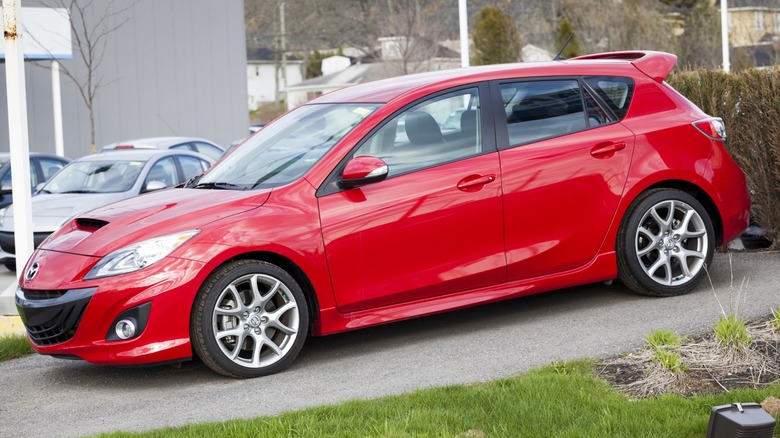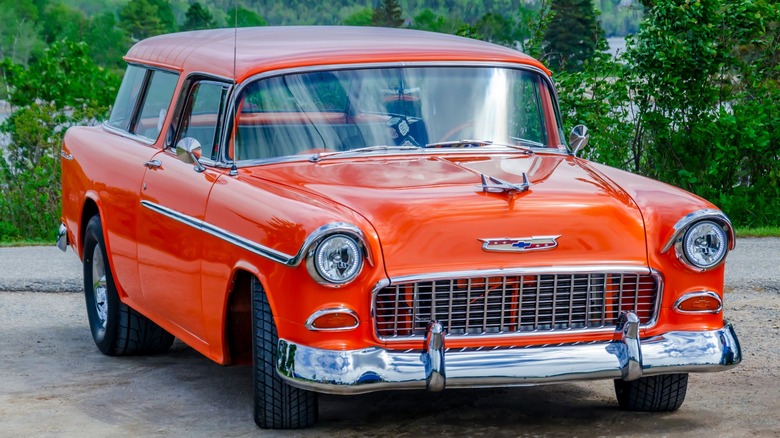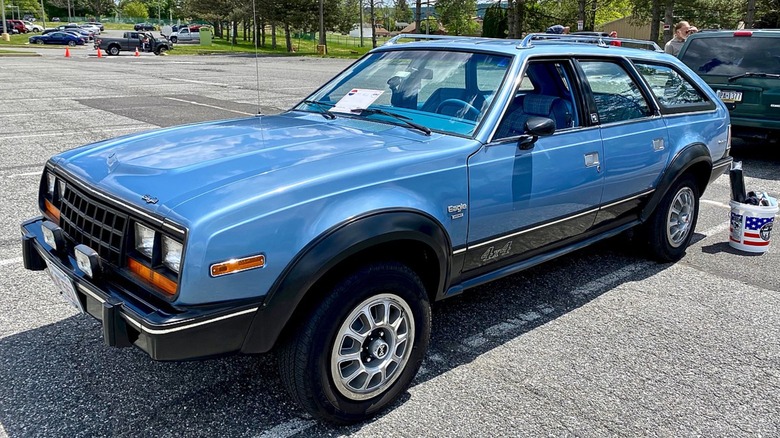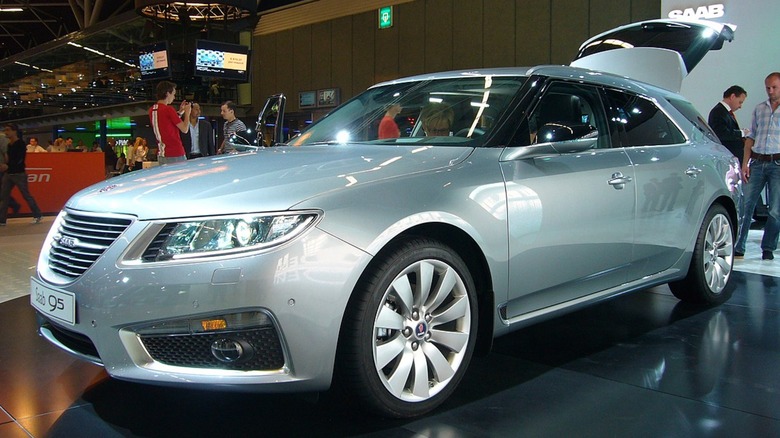10 Discontinued Station Wagons We Want To See Make A Comeback
If you grew up in the '70s or '80s, at one time you likely hated the family station wagon for being so ordinary and dull. Yet, in some strange twist of fate, the lowly station wagon has become a vaunted and desirable automobile by enthusiasts today. This can be verified in various forums, subreddits, and even through the writings of respectable automobile journalists and writers of many popular websites and blogs. Despite this increasing popularity among those with a penchant for talk of horsepower and forced induction, the wagon has fallen out of favor with the people who actually buy new cars.
The grocery getter of today is the crossover or SUV. These vehicles, which have come to be seen as something of a scourge, are not so different from the old-school wagons. They also seat seven and have cargo space in the back, but the main difference is that a modern crossover lacks any soul. They are less enjoyable to drive and keep drivers insulated from the road and the outside world in general.
That's why old wagons will always hold a special place for a certain cohort of enthusiasts, even if they can't be found on dealer lots. In an alternate universe, perhaps the wagon could continue to be a thing. Perhaps it continues to be a thing somewhere far away. Regardless, if that were the case, these are the 10 we'd like to see for a comeback.
Mazdaspeed3
Ever since Japanese automakers made inroads into the American and European markets, Mazda has been there, but it has always been more like the plucky little brother tagging along. Proof of Mazda's innovative and daring nature shines through in its Mazdaspeed3, an underappreciated and quick little wagon.
With 263 horsepower from its direct-injected and turbocharged 2.3-liter engine, the Mazdaspeed3 could keep up with nearly anything in its class and look good while doing it. The lightweight car received upgraded suspension and brakes, making it a good performer with a price that offered an excellent performance value. The car — which debuted in 2006 — received an update in 2010, as second-gen cars featured a huge air scoop for the intercooler, making them instantly recognizable. Mazda even managed to dial in the traction control to keep the torque steer from its front-wheel-drive manageable.
2013 was the last year for this little turbo rocket. Mazda has since gone for a more upscale market and fast compact cars are no longer on the roster. That is unfortunate, as Mazda has always made excellent driver's cars, and it seems high time they return to that heritage. A new performance version of the latest Mazdaspeed3 would be a welcome sight on the road today.
Chevrolet Nomad
Chevrolet hardtops from the '50s have always received a good deal of attention. Even in the '70s and '80s, they were popular vintage cars, and that popularity has not waned. However, many may not realize that Chevrolet offered a station wagon version of the same popular hardtops called the Nomad.
Available as a shooting brake, meaning it has two doors and a rear cargo area, the Nomad adopted the same lines that made cars like the '57 Chevy iconic classics. Though the model lasted for many years, it is those built for the 1955, 1956, and 1957 model years that remain the most highly cherished. This is for good reason, as they are fine-looking automobiles with classic lines, good handling, and ample interior space, including the rear cargo area.
While the Nomads went out of production long ago, perhaps we could do with a modern version built with the original design. A modern copy would be a breath of fresh air among the dull Maximas and Accords that proliferate in our dealer lots today. It is time to see a classically styled Nomad with a modern drivetrain and custom interior, replete with all the modern touchscreens, safety features, and comfort we enjoy today — someone would buy that car.
Oldsmobile Vista Cruiser
The term vista is often associated with places providing a scenic view. Oldsmobile's use of the term in its Vista Cruiser station wagon is apt as it is one of few models to include a scenic window above the passenger roofline. Of course, it is also impossible to mention this model of car without including "That '70s Show" in the conversation. In this 2000s comedy, teens from suburban Wisconsin do what teens do, often in the family Vista Cruiser, which gets frequent mentions that have helped burn the car into pop culture history.
The Vista Cruiser is a full-size station wagon in the classic mold of the American family vehicle. Built as a wagon version of the Cutlass, the Vista Cruiser was a stand-alone model that remained in production from 1964 through 1977. Most copies of this car sold were utterly ordinary, with average V8 engines producing enough torque for a comfortable family highway journey. Some models, however, were ordered from the factory with the powerful 455 V8, making for some pretty quick getting of the groceries –- if you had a cool mom, that is.
Today, companies sell giant truck-based SUVs like the Chevrolet Tahoe and the Grand Wagoneer. Why should families suffer through driving a truck when a much more pleasant car of similar size could be done? How about a modern interpretation of the Vista Cruiser, created to compete with today's large SUVs? It could be done. However, it would have to be a Buick since Oldsmobile folded decades ago.
Mercedes-Benz S124
For a time, you could find a Mercedes-Benz S124 — which is derived from the W124 sedan — chassis usually labeled as a 300TE or 300TD with the 3.0-liter straight-6 engine. The TE model denotes a gasoline engine while the TD denotes a turbodiesel model. These roamed the streets new from dealers from 1986 until 1996 when the E-Class replaced it. They are known for being robust platforms built with extremely high standards while delivering sublime luxury driving.
The wagon came a year after the sedan but included the same iconic styling. Though it has been some time since these left production, they are fondly remembered by many and often considered among the best Mercedes ever built. Some might say they are the perfect car. Part of what makes them such good vehicles is that Mercedes allowed them to be vastly over-engineered from the start. At the time, Mercedes wanted extraordinary quality above all else and spared no expense in achieving that. There is no modern Benz quite like it.
While Mercedes offers a wagon in its current lineup, there is room for an old S124 series return. If Mercedes could pull out the exact same tooling from the original factory assembly lines and begin producing the identical S124 wagons today, they would surely have some sales immediately. Perhaps a few modern appointments to integrate navigation and Bluetooth are in order, but the analog gauges and physical buttons and controls must stay, no matter what. Mercedes-Benz may not know it, but this is what the people want.
Buick Roadmaster
The Roadmaster label has been affixed to Buick cars for many years. In fact, 1936 marked the first year for the moniker, which lasted with the brand through 1996. Roadmaster has been applied to both sedans and wagons, but it is the final iteration wagon we are concerned with. This one arrived in 1991 and continued through the end of the line in 1996. It was the full-size model of Buick, retaining the big V8 setup that has since fallen out of favor and is sadly absent from new car dealers today.
The spacious wagon chassis was shared by a Chevrolet Caprice and Oldsmobile Custom Cruiser. These were powered initially by the 5.0-liter L03 V8 but received an upgrade with the 5.7-liter L05 in its second year. However, the ultimate Roadmaster is one made from 1994 featuring the legendary LT1 small block V8 under the hood and a myriad of tuning and performance possibilities courtesy of Corvette and Camaro aftermarket parts support.
These big and heavy cars may not be the most environmentally friendly. Then again, how is a Tahoe any better? If Buick could see to it to recreate its iconic Roadmaster with a modern small block LS V8 engine, it might save the brand. It's time for another '90s reboot.
Citroën DS Break
In the aftermath of WWII, French car companies built small and affordable cars to get society back on the move. However, when the initial rebuilding period had waned, the French brought us the illustrious Citroën DS in 1955. the DS featured an extraordinarily high level of engineering cleverness. Its suspension used a combination of gas and fluid to create a supple, forgiving, yet stable ride without springs while the same fluid ran the clutch and brakes. It introduced safety into the design like nothing before, and one even saved French Prime Minister Charles De Gaulle from assassination.
While the DS was more of a fastback, it was also offered as a wagon with several variants called the DS Break and Break Confort, a six-seater, Familiale, an eight-seater, and Commerciale, a panel wagon. Although these models were much longer, they retained all of the wonderful features of the DS, plus a substantial area for cargo in the rear. The genius of using this vehicle for hauling cargo is the hydropneumatic suspension that will automatically level the car no matter how much weight you put in it.
The DS was extraordinarily advanced for its time and its features continue to impress today. However, the engines are weak compared to modern examples. If Citroën could re-release the DS Break with a modern fuel-injected engine and export it to the United States, we would see a lot of happy American odd car aficionados.
BMW 5-Series Touring
German automaker BMW has been making fine luxury automobiles for well over a century, and the company is celebrated for creating genuine drivers' cars with sporting driving dynamics. BMW found success in the post-war period with its line of small but powerful cars known to be fun to drive and extremely tunable. However, it was in the '90s that the luxury and sporty sides truly merged to create "The Ultimate Driving Machine."
A 5-Series Touring built from 1989 to 1995, known as the E34 chassis, presents itself as a spacious luxury family vehicle but delivers excellent handling and good performance behind the wheel. The steering is tight and responsive, while the exterior is sleek and conservative. BMW's design at this time is near perfect. The overwrought designs of today with the garish grilles and overuse of sharp angles are far less appealing –- to some -– than these classic drivers.
Beyond that, you could buy a BMW M5 Touring performance wagon in 1992! American automakers don't do performance wagons and that is something we need more of now, not another ridiculous BMW X5 M. Like the Mercedes S124 model, BMW would do fine to dust off the tooling from 1989 and give us a brand new 1992 M5 Touring to purchase brand new. Add a small touchscreen for navigation and keep the rest exactly the same. If nobody else, BMW will have readers of SlashGear and similar publications singing its praises forever.
AMC Eagle
Today, the crossover dominates new car sales, but what is a crossover besides a station wagon on a lift kit with larger wheels? Of course, this trend started long before the term crossover entered the mainstream lexicon.
Take, for instance, the AMC Eagle. With a limited budget and the need to be innovative, AMC engineers put together a new car using parts borrowed from the bins at its Jeep factories. The all-wheel-drive system developed for Jeeps was ingenious and was a useful feature to people in many parts of the country. Subaru was selling AWD cars already, but they were small imports, not large all-American station wagons.
The Eagle initially took off, exceeding sales expectations, and made huge inroads for the plucky independent automaker. Despite taking an odd position within the automotive landscape, the AMC Eagle found traction by fulfilling a niche for people who need a capable and rugged vehicle but don't want a big truck or Jeep. AMC continued production of the Eagle until 1987, but when Chrysler took ownership of AMC the Eagle soon found itself on the chopping block.
Chevrolet Chevelle SS Wagon
For many years, the Chevrolet Chevelle stood as the quintessential representative of the golden age of muscle cars. While it was just another car in the Chevrolet lineup when it first came out, it has since become an iconic symbol of power.
Chevrolet produced the Chevelle from 1963 to 1977 in three generations, and the El Camino was also based on the Chevelle. The most popular models have always been the two-door hardtops, although millions were sold as sedans and wagons. While a base model inline-6 engine could be chosen, it was the V8s that are at the core of what makes a Chevelle great. Furthermore, Chevelles were offered from the start with big block power, even in the wagons.
While the hardtops always got all the love, at least for one year, Chevrolet released a Chevelle SS wagon. In 1973, you could order one that came with the venerated big block 454 V8, and it came complete with official SS badging inside and out. With a set of factory Rallye rims, this was a true muscle car for moms. Sadly, by 1973, the big block was only good for 245 horsepower, but better late than never.
Does Chevrolet need another big and fast family wagon? Perhaps it does. Should it be an identical copy of a 1973 Chevelle? Probably not. However, a modern interpretation of the classic Chevelle — complete with the return of the Chevelle SS badge — would surely set some old-school fans alight. It could even be an electric version!
Saab 9-5 SportCombi
It's a shame that Saab went down the way it did. Its cars were always interesting, and Saab owners were loyal to a fault. Before Saab went headlong into a financial iceberg, it had a couple of models on deck and ready for production within the next year or two. In fact, Saab even had a few wagons among its quirky cars. A final mockup for a Saab 9-5 SportCombi wagon was ready for production before bankruptcy hit.
The second generation Saab 9-5 entered into production in 2010, but this coincided with extreme financial pressures on the company and its subsequent sale to Spyker Cars. Attempts to save the company eventually failed and only a handful of these sedans made it out of the factory. The SportCombi version had already been announced and would have entered production soon after the sedans started shipping to dealers. Yet, fate intervened, and the SportCombi now only exists in prototype form, whose whereabouts are unknown.
The last 9-5 was a great-looking European sports sedan. No doubt it would have been well-received if given the chance. The styling and design of the car were modern at the time, but it is not hard to imagine it could still be fresh enough to be on sale now with a moderate refresh and design tweak to update its appearance.
[Featured image by Rutger van der Maar via Wikimedia Commons | Cropped and scaled | CC BY 2.0]










